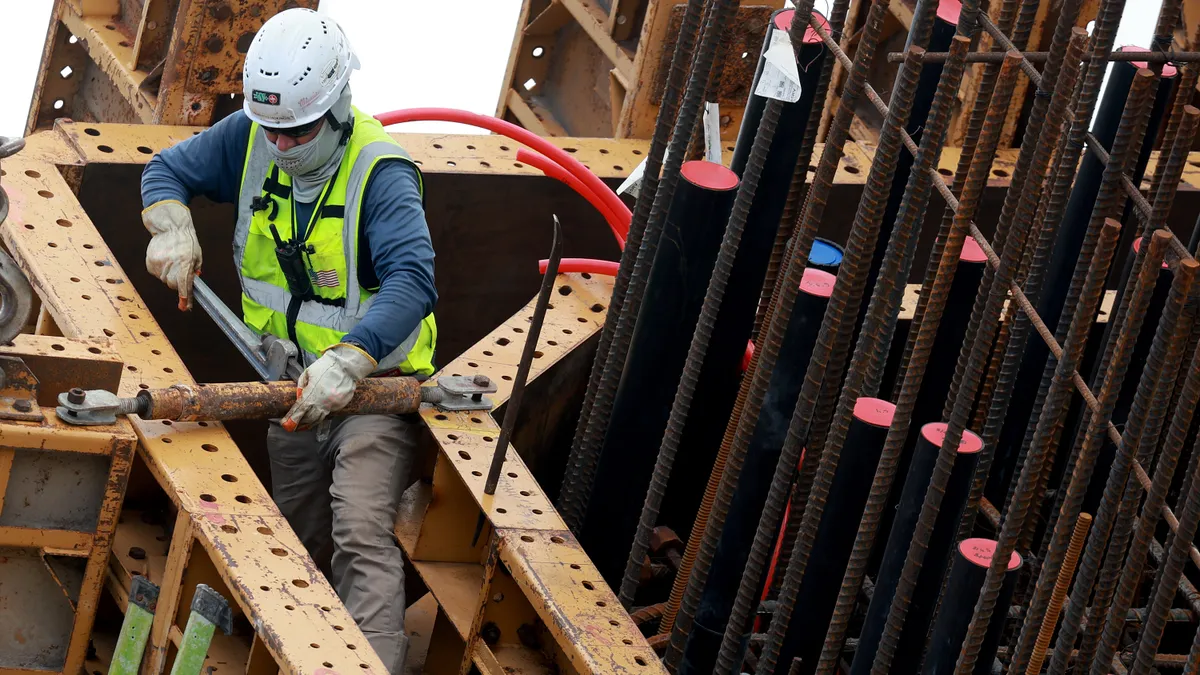Contractors are staying busy with infrastructure work as federal money continues to roll out. However, worker shortages and high inflation continue to strain the sector, and spending on transit and fossil fuel projects slumped in the past year.
According to the U.S. Census Bureau, total construction spending was up 14% from December 2022 to December 2023 in (non inflation-adjusted) dollars, with nonresidential spending rising 20%, driven by manufacturing work as well as infrastructure segments like roads and waste.
“It doesn’t seem like anyone is necessarily struggling in terms of activity,” said Associated Builders and Contractors Economist Zachary Fritz. “Our expectation is that we’re going to keep seeing infrastructure spending dollars hitting the ground, and you’re going to see these projects progress.”
Change in US infrastructure spending by sector
In addition to federal funding, infrastructure projects have benefited from an overall strong economy, said Ken Simonson, chief economist of Associated General Contractors of America. Federal pandemic relief plus healthy local government budgets pushed work forward.
“Even though the money wasn’t earmarked for construction, it allowed governments with balanced-budget requirements to avoid cutbacks,” Simonson said.
Respondents to AGC’s 2024 Construction Hiring and Business Outlook predicted infrastructure project opportunities to increase in 2024, with 32% expecting the value of projects in water and sewer to be higher, 30% in transportation and bridge/highway, 29% in federal projects and 25% in the power sector.
While most infrastructure work grew in 2023, spending on oil and gas as well as transit projects actually fell year over year. Those sectors faced unique challenges.
Fossil fuel projects have increasingly struggled to get financing as banks reduce their footprint in the sector. As for transit, COVID-19 reduced ridership and revenues, and subway and light rail construction has seen “a little bit of a lag” as a result, said Alison Black, senior vice president and chief economist at American Road and Transportation Builders Association. Still, more work is now happening on station terminals and on Amtrak class 1 railroads.
Infrastructure headwinds
In AGC’s 2024 Outlook, 69% of respondents expect to increase their headcount and hiring over the next 12 months, though 55% believe it will be harder to hire. Simonson noted that contractors are still struggling to staff their jobs, which is impacting work.
“Labor costs certainly are rising and projects may take longer if you only have 40 electricians and need 100,” he said. “Some projects have been put on pause or scaled back or are taking longer than had been expected because of a shortage of critical labor.”
Projects were also hampered by shortages in materials, especially switchgear transformers and other electrical equipment, Simonson said. And while inflation is not as bad as it was a few years ago, it hasn’t disappeared, according to Black.
“Some material prices have moderated but there’s still upward pressure on some different types of commodities. We’re not completely out of the woods yet,” said Black.
Regulatory and the judicial review processes are also adding hurdles to federal funds being released for work, Simonson said. For example, Build America, Buy America regulations require certain materials to be domestically produced on federal projects, and contractors say getting a waiver is now taking longer.
“It’s bumped up to a much higher level than when you just went to the Federal Highway state office and said ‘here’s my evidence’” that it’s the only one available, Simonson said.
More growth ahead for some sectors
Fritz has recently seen increased activity in water, sewage and waste disposal-related projects, and anticipates that public power builds are going to start in 2024.
“[Power projects] typically take the longest to plan, and are most likely to be delayed,” he said.
While transit agencies continue to grapple with pandemic-related impacts, Marsia Geldert-Murphey, president of the American Society of Civil Engineers, said that these projects are a key part of a growing focus on resilience and sustainability in infrastructure..
“Passenger rail and light rail is something that has not [historically] seen significant funding, so we are seeing those projects move forward,” she said.
Geldert-Murphey is also seeing increased activity in ports and inland waterways as well as bridge projects, with $40 billion from the IIJA earmarked for that work. Now those dollars are translating to shovels in the ground.
“We are seeing major projects like the Brent Spence Bridge between Ohio and Kentucky and also the Hudson River Tunnel in New York receive funding to begin,” Geldert-Murphey said.
Correction: In a previous version of this post, Geldert-Murphey’s name was misspelled.



















